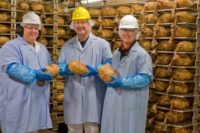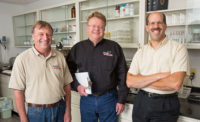Butterball’s Mount Olive, N.C., processing plant, is among the most recent beneficiaries of this commitment, with the company having completely overhauled its deboning area one year ago — automating the process to make operations more efficient and the jobs easier for the employees in that area.
In 2010, Butterball’s operations team faced a surprise development at its Mount Olive facility — a whopping turnover rate in the deboning area in the range of 150 to 200 percent, which had begun to affect the core values and bottom line of the company, from worker safety to product quality and yield performance.
Furthermore, says Mike Bliss, vice president of operations for Butterball, the turnover rate was, in a sense, forcing the Mount Olive deboning team to run in place in terms of employee job performance.
“With that amount of turnover, we were not only fighting through the normal issues associated with it — the costs of orientation, selection and hiring — but also training was continuous,” he explains. “We were always in a training mode.”
The enormous impact of this turnover rate drove Butterball to look more closely at automation of the deboning process — a system that it had knowledge about and now believed could help solve the problem in two ways.
“It made sense to automate debone not just for the advantage of needing fewer people, but also [because the] positions that would exist after installation of the system are much easier to train, teach and do,” Bliss says. “[We eliminated] 100-plus positions, but those that remained were actually easier to train, get a person on board and up to operating speed more quickly.”
At the time of The National Provisioner’s visit to the facility, Bliss reported that 10 months into the system’s operation, turnover in the debone area is already less than 70 percent.
Committing to change
Once Butterball had committed to overhauling the debone area of the Mount Olive facility, a massive plan was put in place, spearheaded by Bliss and Steve Valesko, vice president of engineering at Butterball, and their respective teams. Impressively enough, and a credit to the teamwork and communication across all parties involved, the project was completed over the Christmas and New Year’s holiday at the end of 2010 — in only nine days, as scheduled.
“We developed a schedule that was basically down to every single individual hour,” Valesko says. “We ran two 12-hour shifts, 24 hours a day, and every single day we had meetings in the morning and at night to determine where we were, what we had to catch up on and what the goals were for the next shift.”
Joe Nalley, Butterball’s chief operating officer, says the company had several contingency plans in place in case of delays or issues but ended up not needing any of them.
“We had a ramp-up schedule set up, where we said we were going to have ‘x’ amount of birds go through on a certain day, as sort of a dry-run on the equipment,” Nalley says. “Then the schedule was a slow, steady ramp-up, and these guys hit every single milestone.”
“We never missed a bird,” Bliss adds, stating that the project’s success also hinged on the fact that the facility’s entire workforce had bought into the change and pitched in to make the event happen in a quick, efficient manner, from teardown of the original deboning lines, to installation of the new system, to training on the new system.
“Everyone was tired of 150 to 200 percent turnover, tired of not meeting goals and objectives because of it,” he explains. “Everyone saw this opportunity as the chance to get back to where we were, with things manageable again.
“When I came in here Christmas morning [the first day of teardown], it was like ants at a picnic,” Bliss continues. “People were in one line going out and one line coming in, carrying scrap and equipment out on their shoulders, on lifts, and taking it outside to clear that room out for the contractors to come in and start working on the day after Christmas — and nobody complained.”
Employees were trained on the new system between Christmas and New Year’s, while the plant was shut down and installations were underway. After the New Year holiday, training continued, with the opportunity for a more hands-on approach.
“We were to the point where they could actually touch the equipment, turn knobs, see it starting to run a little bit,” Bliss says. At the end of the day, he estimates that the company put several hundred-thousand dollars worth of wages into training over that two-week period, a move that he believes was invaluable during the ramp-up stages.
“People were able, when the first turkeys started coming through, to recognize quickly if something stopped, why it did and what type of adjustment had to be made,” Bliss says. “They might not have been able to make the adjustment perfectly right away, but they knew what a safety being kicked on meant, or if the system was cutting too far into the shoulder or the caps off the shoulder bones.”
A ripple effect
Beyond improving the working conditions and job requirements of the employees who work in the deboning area, Butterball has found several additional positive outcomes brought about by the system and the renovation project overall.
First, Nalley says the project gave the plant, in effect, a “do-over” in terms of its overall operations.
“The debone area had evolved into what it was over a period of 20 years or more, and these guys cleaned that thing out — it was bare walls and bare floors,” he explains. “We started over, and everything that we started over with centered around the flow of this debone system, allowing us to … rethink and redo some things.”
Additionally, Bliss says the system has helped the facility improve the safety and design of the employee’s jobs — which has led to improved yield performance. Bliss attributes this unexpected outcome to the lower turnover, which has allowed employees to get comfortable with their jobs and improve as well. But he also points to the facility’s frame-scrape operations, an area that had always been “very competitive” in the past and has used the improvements of the automated system to post a 30 percent gain in frame-scrape yields.
“We’ve always aggressively scraped our frames, but with the frame-scrape area in the plant that we’ve created, we were able to set up our frame scrape in a more organized manner,” he says. “Today, it’s very well-paced and in-line, so one person may be scraping under the wishbone only, and another may be scraping the keel only, and another may be scraping off the bottom of the ribcage only. So they can focus on one area of the frame as it moves by them, and the way that the frame is presented also has made scraping the frame a lot better.”
Whereas the facility anticipated a yield loss in 2011, Bliss says it will finish the first year of automated deboning operations positive dollars in yield variance versus 2009.
“We aren’t comparing to 2010 because with the high turnover, it wasn’t our best year,” he explains. “So we went back to 2009 and said we’re going to use those performance numbers as our baseline, and before this year ends up, the facility will be at or even slightly better in breast yield than in 2009 with a manual debone system.”









Report Abusive Comment